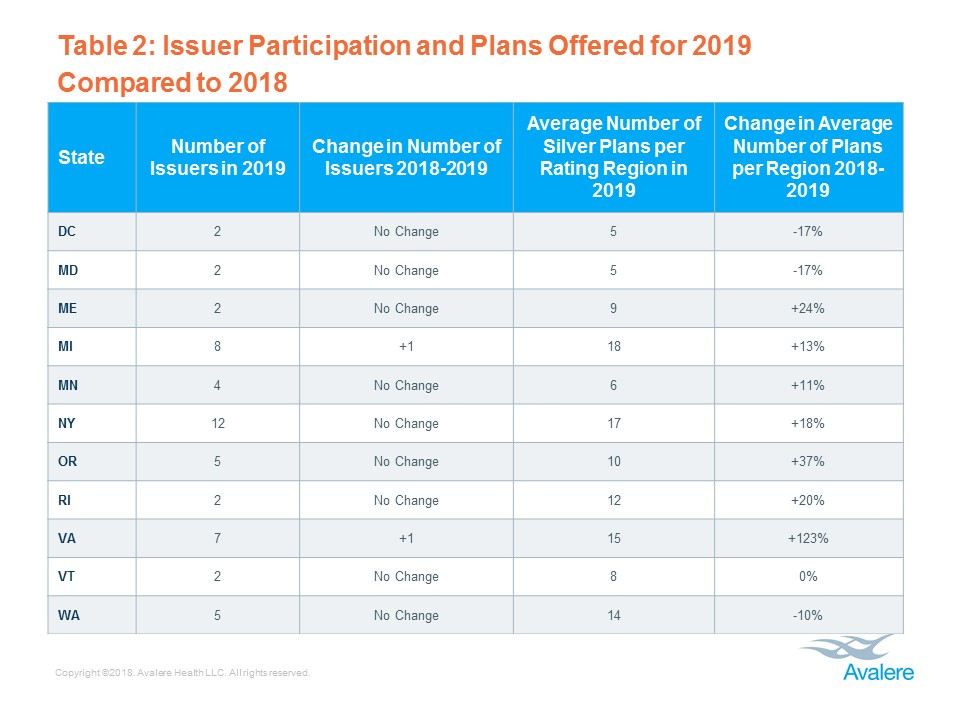Double-Digit Premium Increases Expected in the Exchange Market in 2019
Summary
2019 rate filings suggest increased competition and plan choiceNew research from Avalere finds that proposed 2019 exchange premiums for the most popular exchange plans (silver-level plans) are 15% higher on average compared to 2018 final premiums. If approved, average silver-level exchange plan premiums will be $98 more per month in the states analyzed, up from $642 in 2018 to $740 in 2019.
These findings are based on an Avalere analysis of the complete 2019 individual market proposed rate filings released publicly by 10 states and DC.
“Insurers are starting to gain a better understanding of who is likely to buy their health insurance through the exchanges, but questions about the stability of the market remain,” said Matt Brow, president of Avalere. “This uncertainty is likely to contribute to substantial increases in exchange premiums across many states in 2019.”
According to Avalere experts, a popular choice among consumers from year to year is the silver-level plan with the lowest monthly premium cost. In the states analyzed, on average, the lowest-cost silver plan premium is $111 lower than the premium for the average silver plan; however, in 9 states plus DC, premiums for both the lowest-cost and second-lowest-cost silver plans will be higher in 2019 than in 2018 (Table 1).
What’s Causing the Premium Increases?
According to Avalere experts, contributors to the premium increases for 2019 include: the discontinuation of federal reimbursements for cost-sharing reduction (CSR) plans and state strategies to allow insurers offering plans in the exchanges to recoup the lost reimbursements; the repeal of the individual mandate beginning in 2019; and the lack of federal legislation to stabilize the individual market amidst enrollee risk and structural uncertainties. Among the states that Avalere analyzed, average premium rates increased in all states but Minnesota, where state officials have attributed the premium decline to the state’s reinsurance program.
Avalere also analyzed the number of insurers participating in the exchanges and the number of silver plan choices available to exchange enrollees. For 2019, the number of insurers participating in the exchanges in the states analyzed will remain largely unchanged from 2018, but Virginia and Michigan are each likely to gain an additional exchange issuer. Still, significant geographic differences in participation are expected.
With respect to the number of plans available in the exchanges, many consumers will have more silver plan options to choose from in 2019 than in 2018, according to the analysis. Across rating regions, 7 states will—on average—have more silver plan options in 2019. In Virginia, for example, the average silver plan options per region will more than double. Enrollees in DC, Maryland, and Washington, however, are likely to have 1 fewer exchange option per region on average in 2019 than in 2018.
“The rate filings suggest we may see increased competition and plan choice in many exchanges in 2019,” said Kelly Brantley, vice president at Avalere. “Greater plan choice will allow consumers to select a plan that best meets their health coverage needs.”
Final rates and participation may vary from the proposed plan filings. States and HHS must approve plan filings prior to the start of open enrollment in November. In addition, premiums and plan offerings available to consumers may vary substantially from the findings of this analysis and will depend, to some extent, on the plan chosen and the consumer’s geographic location in the state, age, and smoking status. Plan submission deadlines for rate filings differ by states, but all proposed rates are due by July 16.
Methodology
Avalere’s analysis includes final 2018 premiums and proposed 2019 premiums in DC, MD, ME, MI, MN, NY, OR, RI, VT, VA, and WA. States were selected based on rate filings available and accessible through Department of Insurance websites or the System for Electronic Rate and Form Filing (SERFF) as of June 18, 2018. For the purposes of this analysis, average premiums are not weighted by exchange enrollment in a given rating region or state. 2018 premium data are based on the Robert Wood Johnson Foundation 2018 HIX Compare Datasets, updated as of June 1, 2018. 2019 proposed premiums were collected via rate filings that were publicly available as of June 18, 2018. Per HHS requirements, issuers in each state must uniformly use a set number of geographic rating areas as part of their premium setting. Each state’s market rating areas and methodology for dividing the state into rating areas are subject to variation based on Metropolitan Statistical Areas (MSAs), counties, three-digit zip codes, or MSA/non-MSAs. All premiums are for an individual, 50-year-old non-smoker. Proposed 2019 rate filings are currently under review; final approved rates may be different. Maine and Maryland are currently waiting on approval for their state reinsurance waivers. Issuers in Maine have filed alternative rates if the reinsurance waivers are approved, and issuers in Maryland noted that they would refile their rates if the waiver is approved.
The average number of plans offer by states is determined by Avalere’s analysis of the 2018 and HHS Individual Market Landscape files and proposed rate fillings available and accessible through Department of Insurance websites or SERFF as of June 18, 2018.
To learn more about the ACA and the exchanges, connect with us.









